North Side civic leader Merida Green Ellis and his wife Margaret were of a generation who lived through tremendous changes, being born in the world of cowboys and Native Americans and dying in the world of traffic jams and jazz.
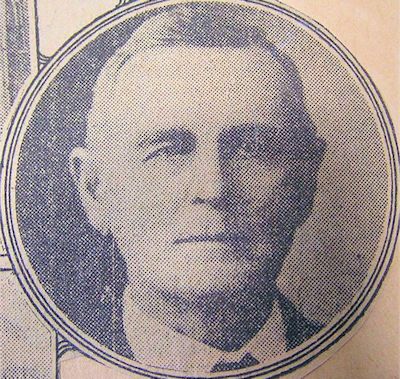 M. G. Ellis (1847-1932) was born in Denton County. Both parents died just months after his birth.
M. G. Ellis (1847-1932) was born in Denton County. Both parents died just months after his birth.
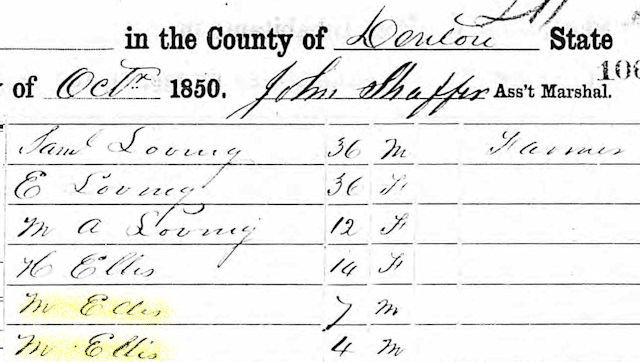 Ellis was raised by Sam and Elizabeth Loving. Elizabeth was the sister of Ellis’s dead mother. Sam and Elizabeth had a daughter, Margaret Ann. Merida was one of the two male M. Ellises listed as living with Sam and Elizabeth in the 1850 Denton census, probably the one listed with an age of four.
Ellis was raised by Sam and Elizabeth Loving. Elizabeth was the sister of Ellis’s dead mother. Sam and Elizabeth had a daughter, Margaret Ann. Merida was one of the two male M. Ellises listed as living with Sam and Elizabeth in the 1850 Denton census, probably the one listed with an age of four.
Soon after that census was taken, the Lovings moved to Tarrant County and settled along Sycamore Creek east of Fort Worth. Merida, like thousands of children after him, grew up playing along that creek.
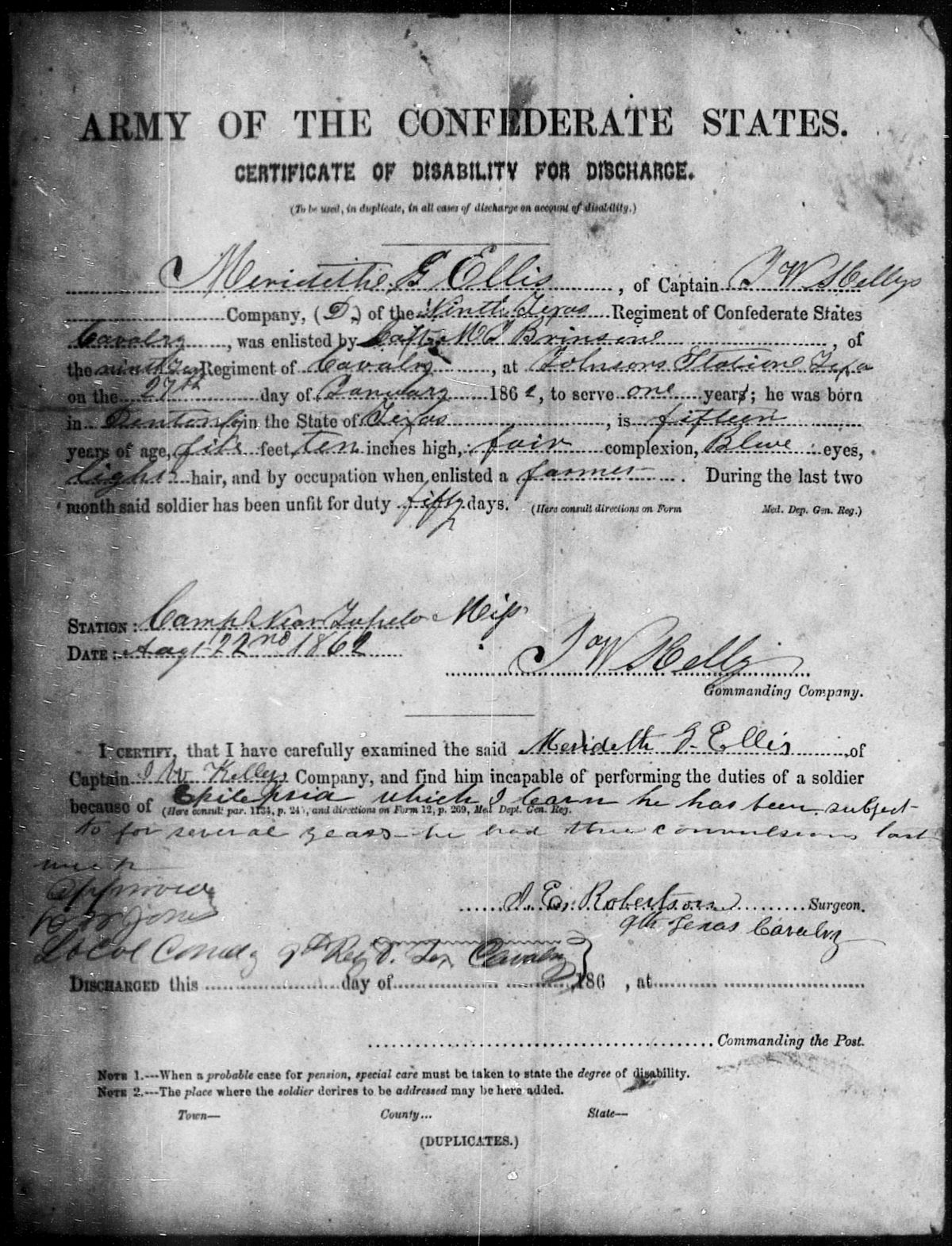 In 1862, at age fifteen, Ellis enlisted in the 9th Texas Cavalry of the Confederate Army. He was in Captain Matthew Jackson Brinson‘s Company E. But Ellis suffered from epileptic seizures and was soon discharged. He reenlisted in 1864 and served to the end of the war.
In 1862, at age fifteen, Ellis enlisted in the 9th Texas Cavalry of the Confederate Army. He was in Captain Matthew Jackson Brinson‘s Company E. But Ellis suffered from epileptic seizures and was soon discharged. He reenlisted in 1864 and served to the end of the war.
 The 1870 census lists Ellis as a farmer in Tarrant County. Also listed on that page are David Mauck, who in 1857 had bought Julian Feild‘s mill on the West Fork of the Trinity River and in 1859 had begun construction of Fort Worth’s new courthouse, and early civic leader Ephraim Merrell Daggett. In the Daggett household was Jeff “Smith,” the mulatto son of Daggett’s son Ephraim Beck and a Daggett slave.
The 1870 census lists Ellis as a farmer in Tarrant County. Also listed on that page are David Mauck, who in 1857 had bought Julian Feild‘s mill on the West Fork of the Trinity River and in 1859 had begun construction of Fort Worth’s new courthouse, and early civic leader Ephraim Merrell Daggett. In the Daggett household was Jeff “Smith,” the mulatto son of Daggett’s son Ephraim Beck and a Daggett slave.
 M. G. Ellis soon began to sell farming implements (city directory listing is 1878), partnering in 1878 with Walter Ament Huffman. Four years later Ellis bought fifteen hundred acres where today’s North Side is and built himself a house and a herd of cattle and began a dairy operation. In 1891, as the area north of the river became more populated, Ellis went into real estate: He turned his dairy into the M. G. Ellis Subdivision and became an early developer of the city of North Fort Worth. He also was president of Cowtown’s original Union Stockyards, which opened in 1889. He also was vice president of Union Stockyards National Bank, also organized in 1889. In 1890 he was among the organizers of Fort Worth Dressed Beef and Packing Company, which preceded the Swift and Armour packing plants.
M. G. Ellis soon began to sell farming implements (city directory listing is 1878), partnering in 1878 with Walter Ament Huffman. Four years later Ellis bought fifteen hundred acres where today’s North Side is and built himself a house and a herd of cattle and began a dairy operation. In 1891, as the area north of the river became more populated, Ellis went into real estate: He turned his dairy into the M. G. Ellis Subdivision and became an early developer of the city of North Fort Worth. He also was president of Cowtown’s original Union Stockyards, which opened in 1889. He also was vice president of Union Stockyards National Bank, also organized in 1889. In 1890 he was among the organizers of Fort Worth Dressed Beef and Packing Company, which preceded the Swift and Armour packing plants.
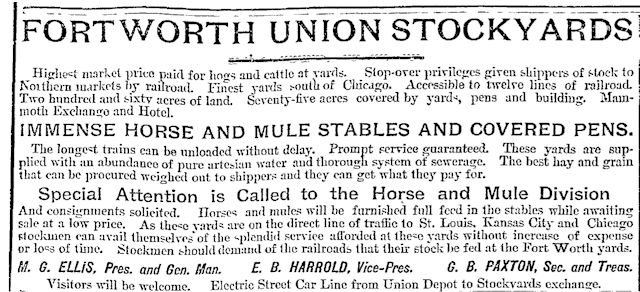 Ad is from 1891. Note that by 1891 residents could ride a streetcar from the Union Depot near today’s Tower 55 to the Stockyards.
Ad is from 1891. Note that by 1891 residents could ride a streetcar from the Union Depot near today’s Tower 55 to the Stockyards.
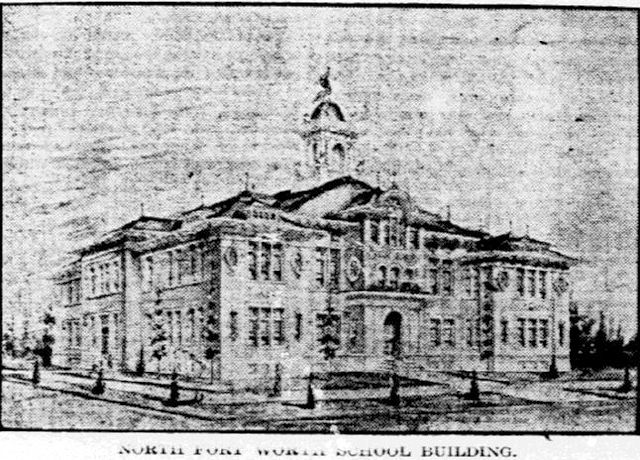 About 1914 Fort Worth renamed North Fort Worth School (1906) for Ellis after the city had annexed the city of North Fort Worth in 1909. The school’s replacement building still stands at the intersection of Northeast 14th and Northeast 20th streets. The North Side’s Ellis Avenue probably is named for him.
About 1914 Fort Worth renamed North Fort Worth School (1906) for Ellis after the city had annexed the city of North Fort Worth in 1909. The school’s replacement building still stands at the intersection of Northeast 14th and Northeast 20th streets. The North Side’s Ellis Avenue probably is named for him.
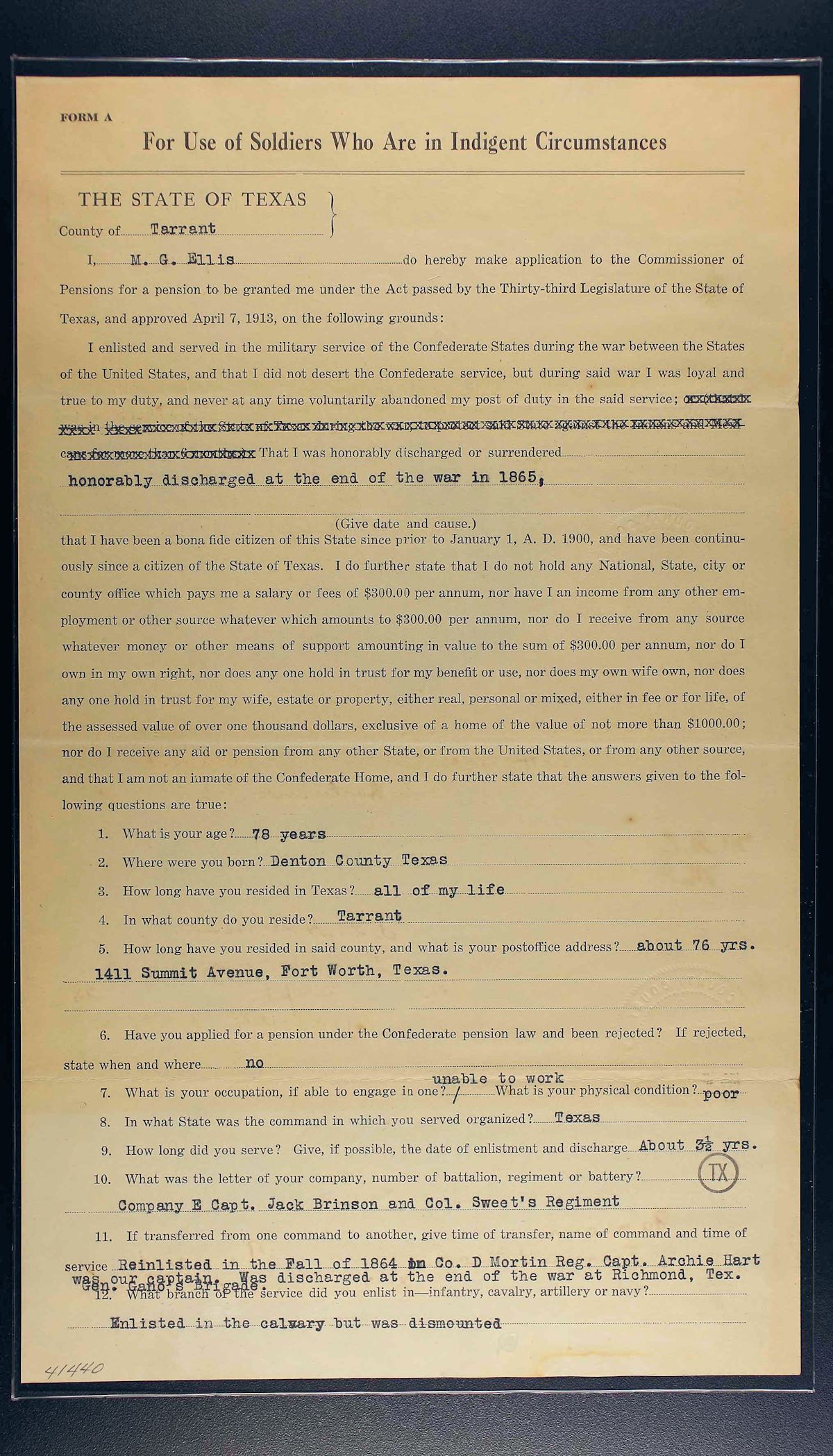 About 1925 Ellis, then seventy-eight years old, applied for a Civil War pension. At the time the Ellises were living on Summit Avenue on Quality Hill.
About 1925 Ellis, then seventy-eight years old, applied for a Civil War pension. At the time the Ellises were living on Summit Avenue on Quality Hill.
But let’s back up to 1868. In that year Ellis proposed to Margaret “Jenkie” Darter (1848-1932). Their honeymoon was a year-long trip across the wilds of west Texas, during which their first child was born. In 1912 Mrs. Ellis was interviewed and remembered her husband’s proposal and their honeymoon:
“When he put the question to me I refused him because I had on a homespun dress. I did not think it was in keeping with the chivalry of that time even to receive a proposal in a homespun dress. I told him if he would wait until I put on my Sunday-go-to-meeting dress I might have a different answer for him. . . . Mr. Ellis was a photographer and lived at Jacksboro. . . . We went on the trip as a business proposition, as there was much money to be made in those days by a traveling photographer. . . . In most of the towns we visited the people had their first opportunity to have their pictures taken, and we did a big business. . . . Mr. Ellis received good money for his pictures. One single tin[type] plate sold for fifty cents [$9 today], large plates $1. . . . Our bridal trip lasted one year and two days, and we settled temporarily in eighteen different towns. It was not difficult for us to get ready in those days, for it took only an hour to pack our household effects and get dressed for travel. Our trip west was in a wagon drawn by horses, but returning we obtained a condemned government wagon, and it was drawn by three yoke of oxen. We had two horses tied to the back of the wagon with which to hunt the oxen, as they were turned loose each night to graze, and it was necessary to round them up. . . . Mr. Ellis named the middle yoke ‘Baptist’ because they would not eat with the others. They were wild and had never been hitched up before. The lead yoke he called ‘Campbellite’ [a religious sect that stressed water immersion for salvation] for they would always make a break for water when they saw it, no matter how far away. The oxen were driven without lines but were trained to go by a long whip and certain words which would not look well in print.
“. . . every morning I got [on] one horse, and Mr. Ellis with the baby [got] on another, and [we] rounded up the oxen. I did this because I was afraid to stay at the wagon alone. We always drove a few hours after dark so that the Indians would not see where we would camp for the night. We would build our fire about one hundred yards from the wagon and would cook supper in a hurry and get away so that the Indians would not find us.
“. . . It was about November 1, 1869, that we started on our return trip. We climbed into the big government wagon and in half a day reached a small fort. People for many miles around had come to the fort for safety because of Indian attacks. They had left their possessions in a hurry. Leaving this fort we traveled for five days through a wilderness. We never saw a living soul but one time, and that was a government wagon loaded with soldiers. They asked us if we were not frightened to travel alone. I said, ‘I am scared to death all the time.’ We sure did hate for them to leave us.
“. . . My worst scare was at San Saba, when the Indians made a raid on the village. There was a dance going on at the time in a public hall, which was close to the doby [adobe] house which we occupied. It was about 11 p.m. when my attention was attracted by a noise at the door of our little house. When I looked up I saw a big Indian pushing over the table which we used as a door. The moon was shining brightly on the form of this half-bent Indian with arms stretched out in the direction of the rocking chair where my infant baby was sleeping. Of course, I screamed, and the Indian backed out. Suddenly I heard a regular stampede of horses running through our yard, followed by a large number of Indians. The horses belonged to the people of the settlement and had been rounded up by the Indians while the people were at the dance. The noise attracted the dancers, and in a moment our yard was filled with white men running after the Indians and firing upon them. The whites killed three men that night and got most of their horses back. One white man was killed. They [the Native Americans] did not capture him in order to scalp him.
“We drove through Fort Worth on November 19, 1869, on our way to my father’s home. When we got near my father’s house, my husband insisted that I walk out on the tongue of the wagon and cry out ‘hello’ to see if the people would recognize my voice.
“I was answered by my dear father, who said with tears in his eyes: ‘Heaven has blessed me in seeing you again, child.’”
 Merida Green and Margaret Ellis were married sixty-four years. He died on July 27, 1932. She died on November 21, 1932. Her obituary recounts their honeymoon trip. Note that the Ellises bought their house with money saved from selling tintypes. Worth Street is near the intersection of 8th Avenue and Rosedale Street.
Merida Green and Margaret Ellis were married sixty-four years. He died on July 27, 1932. She died on November 21, 1932. Her obituary recounts their honeymoon trip. Note that the Ellises bought their house with money saved from selling tintypes. Worth Street is near the intersection of 8th Avenue and Rosedale Street.
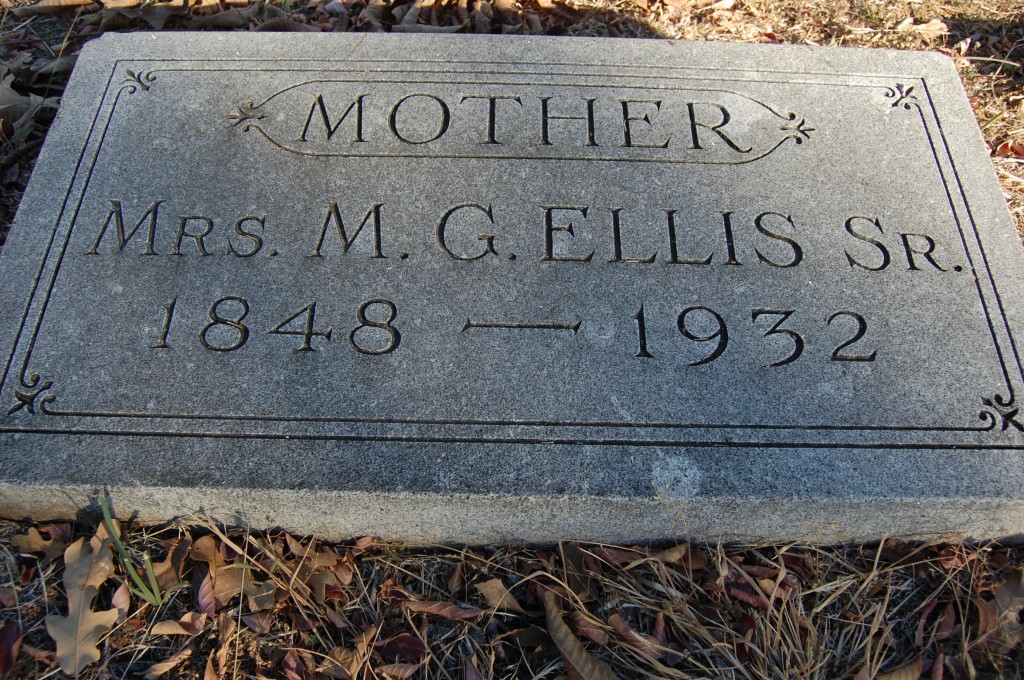
 The Ellises, who were born in the world of cowboys and Native Americans and died in the world of traffic jams and jazz, are buried in Pioneers Rest Cemetery.
The Ellises, who were born in the world of cowboys and Native Americans and died in the world of traffic jams and jazz, are buried in Pioneers Rest Cemetery.






I grew up in Fort Worth. I love the history that you write about, and daily, I read what you have posted for that day. I especially look forward to Sunday. On Sunday you usually post something new.
As a footnote…I knew Marsha and Charles. The one you did when you and Marsha went exploring was great..and as always, I learned something. If you know the Brandts…Bob and I have known each other for more than 40 years now. He’s the big brother that I never had. Marsha and Charles were wonderful people and I always enjoyed the time I spent with them from time to time. Keep doing what you obviously love to do, It’s wonderful, and thank you for doing this blog.
Thanks, Wes. Still can’t believe how quickly we lost Marcia and Charles. Almost every day I read or see something that I want to tell Marcia about and then have to catch myself . . .